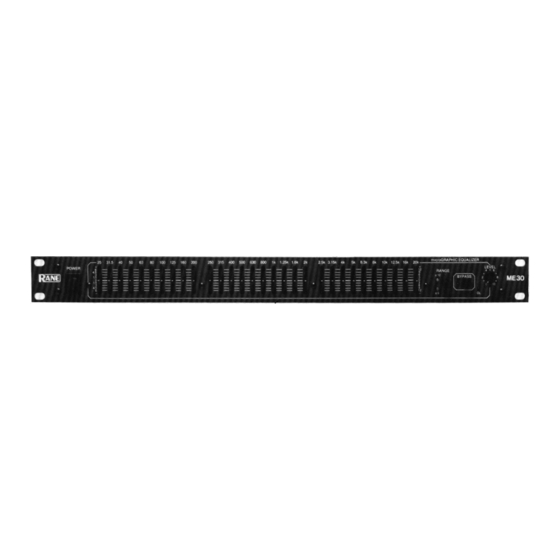
Advertisement
Advertisement
Table of Contents

Subscribe to Our Youtube Channel
Summary of Contents for Rane ME 15
- Page 1 ME 15 and ME 30 OPERATING SERVICE MANUAL...
-
Page 2: Front Panel Description
EQ section in the event of power loss or unit failure. 5. OVERLOAD INDICATOR: This red LED lights up if any section of the ME 15/30 is within 4 dB of clipping. Occasional blinking of this LED is acceptable, but if it remains on more than intermittently you should turn down either the equalizer’s level control(s) or reduce the... -
Page 3: Rear Panel Description
For balanced signals use microphone cable (two conductor with shield) with a stereo 1/4" plug on one end for the ME 15/30, wired as described below, and either a stereo 1/4" or three-pin connector as dictated by the signal source on the other end. Rane adheres to the international and U.S. - Page 4 Connect the ME 15/30 just before the amplifier or active crossover if one is used. Take any required line gain before and/or in the ME 15/30; avoid taking a lot of gain in the crossover or power amps as this may create noise or hum problems.
- Page 5 IV. OPERATING PROCEDURES The ME 15 and ME 30 are extremely accurate, professional quality instruments capable of precise equalization down to a fraction of a dB. You can expect several advantages from your constant-Q equalizer over conventional designs: Moving one sliderwill not affect neighboring filters as much, so you won’t spend time re-adjusting sliders (we call this “equalizing the...
- Page 6 V. SPECIFICATIONS Constant-Q Bandpass Filters: ME 15: 2/3 octave bandwidths on precise ISO centers, 25-16 kHz ME 30: 1/3 octave bandwidths on precise ISO centers, 25-20 kHz Boost/Cut Range: switchable ±6 dB or ±l2 dB Built-in Low Cut Filter: -3 dB at 20 Hz (18 dB per octave)
















Need help?
Do you have a question about the ME 15 and is the answer not in the manual?
Questions and answers